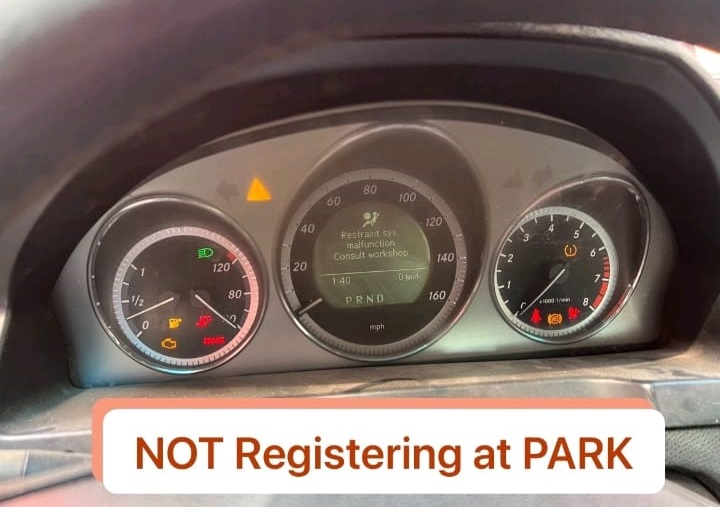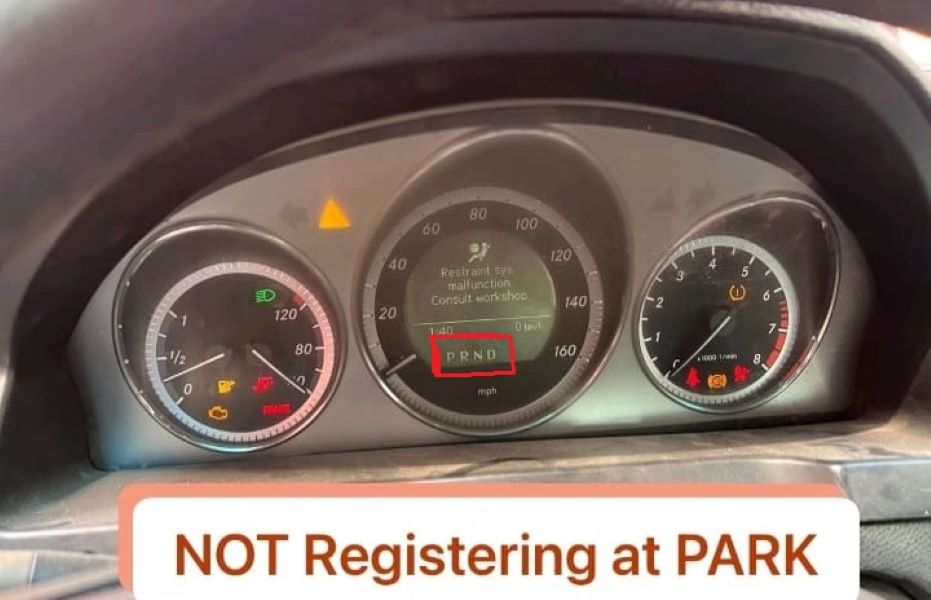Table of Contents
Transmission Not in Park: Mercedes C300 W204 Case Study & Fix
Seeing “Transmission Not in Park” on the cluster while your selector is already in P is more than annoying; it’s a safety risk (roll-away) and a diagnostic trap. This case study walks through a real Mercedes-Benz C300 W204 (M272, 4MATIC) repair where a prior gearbox replacement did not fix the warning.
The root cause wasn’t the transmission at all it was CAN communication integrity. Use this guide to avoid part-swapping and resolve the fault correctly.

Case Snapshot
| Item | Detail |
|---|---|
| Vehicle | Mercedes-Benz W204 (M272, 4MATIC) |
| Customer complaint | “Transmission Not in Park” warning persists even with selector in P |
| Previous work | Transmission gearbox replaced elsewhere (warning remained) |
| Initial scan | No comm with TCU (“device unable to communicate”) |
| Root cause | CAN L open-circuit + ground short in transmission network wiring |
| Final fix | Repair CAN L break and ground short → restore comms → P position recognized |
| Outcome | Warning cleared, smooth operation, verified on road test |

What the Warning Actually Means
“Transmission Not in Park” indicates the car does not trust that the gearbox is truly in P. The reason can be:
- – Selector path (ESM/range sensor) not communicating,
- – TCU/EGS not reachable,
- – Wiring/CAN faults (high/low lines, grounds, power feed),
- – Mechanical selector/park lock issues (less common than comm faults).
When the network goes noisy or open, modules stop “agreeing” on the selector status so the cluster warns you.
Symptoms You Might See
- – Warning appears even when the lever is in P
- – Intermittent or no communication with transmission control (VGS/EGS)
- – Shift interlock oddities, start/stop inconsistencies
- – Occasional ESP/ABS messages (shared network effects)
Diagnostic Process We Used (Repeatable Workflow)
1. Global short test (OE-level scan):
Tried to talk to all modules. TCU/EGS returned no communication. Other modules (engine/ESP/DSI) logged comms errors pointing toward the drivetrain network.
2. Power supply sanity checks:
Verified battery/charging health. Checked Front SAM power feed for the transmission (ex: Fuse 38, 10 A in this case*) -> OK.
*Always confirm fuse/position in WIS for your exact VIN.
3. Network triage (CAN):
- – Checked CAN H and CAN L continuity from the transmission branch.
- – Measured resistance across CAN H/L with ignition OFF.
- – Scoped voltage levels with ignition ON.

4. Findings:
- – CAN H: OK continuity.
- – CAN L: Open circuit.
- – Ground: Short to ground detected in the same loom.



5. Repair:
- – Repaired the open on CAN L and corrected the ground short.
- – Inspected loom routing for chafe points and moisture ingress; rewrapped and strain-relieved.
6. Validation:
- – Network now stable; TCU accessible.
- – Selector P reported correctly; warning gone.
- – Final road test with live data logging no return of faults.

CAN Quick Reference (Useful When Verifying the Fix)
| Test | Good Network (typical) | What Went Wrong Here |
|---|---|---|
| Resistance across CAN H–L (ignition OFF) | ~60 Ω (two 120 Ω in parallel) | Open on CAN L → reading abnormal (often ~120 Ω or OL) |
| Idle voltage (ignition ON) | Both ~2.5 V (recessive) | Open/short → unstable or nonsensical readings |
| Dominant state (scope) | CAN H ~3.5 V, CAN L ~1.5 V | One line open → asymmetric or missing transitions |
Pro tip: If you read ~120 Ω, one termination is likely missing/disconnected. “OL” or mega-ohms means a break. Erratic readings usually point to shorts or water ingress.
Symptom → Cause → Fix
| Symptom | Likely Cause(s) | Fix / What to Verify |
|---|---|---|
| “Not in Park” with lever in P | Range/selector signal not reaching TCU; CAN wiring fault; TCU offline | Restore CAN integrity; verify TCU power/ground; re-scan |
| Intermittent no-start / shift lock quirks | Low voltage; noisy network | Battery/alt test; load test grounds; CAN scope |
| Warning persists after gearbox replacement | Misdiagnosed comm issue | Stop replacing mechanical parts; fix network path |
| Multiple comm codes across modules | Backbone/branch fault, water ingress | Locate chafe, connector corrosion, or pin push-backs |
“Before You Replace the Gearbox” Checklist
| Step | What to Do | Tools |
|---|---|---|
| 1 | Global scan, save freeze frames | XENTRY/OE-level |
| 2 | Verify power/grounds to TCU | DMM, load probe |
| 3 | Check fuse(s) per VIN (Front SAM etc.) | WIS diagram |
| 4 | Measure CAN resistance H–L | DMM |
| 5 | Scope CAN (idle/dominant) | Oscilloscope |
| 6 | Continuity: CAN H, CAN L to TCU | DMM |
| 7 | Inspect loom for chafe/water | Visual, borescope |
| 8 | Repair → clear codes → re-test | Scan tool |
Explore More Mercedes Transmission Issues
For a deeper dive into gearbox problems slipping into Neutral, delayed/harsh shifts, “Not in P” warnings, and hybrid faults visit our hub: Mercedes Transmission Issues – Causes and Fixes. You’ll find grouped case studies, step-by-step diagnostics, symptom–cause–fix tables, and prevention tips to resolve shifting issues quickly and confidently.
DIY vs Professional Tasks
| Task | DIY | Pro Recommended | Why |
|---|---|---|---|
| Battery/charging test | OK | Eliminates low-voltage noise factors | |
| Fuse check (by VIN) | OK | Simple, quick elimination | |
| CAN resistance (basic) | OK | Easy with DMM; engine OFF | |
| CAN scoping/interpretation | OK | Requires experience/equipment | |
| Loom repair/splicing | OK | Quality solder/heat-shrink; safe routing | |
| Module coding/adaptations | OK | Needed if components are replaced |
Results & Road Test
After repairing CAN L and the ground fault, the network stabilized immediately:
- – The P position registered correctly.
- – The “Transmission Not in Park” warning cleared.
- – Vehicle passed a long road test without any comm-related codes.
This outcome underscores a critical lesson: communication integrity can masquerade as a drivetrain failure. If you don’t verify the network, you risk expensive (and useless) mechanical replacements.
FAQs: Transmission Not in Park
1) What does “Transmission Not in Park” actually mean?
The car cannot confirm that the gearbox is in P. That can be due to a faulty selector/range sensor, TCU power/ground issues, or very often CAN wiring faults that prevent modules from agreeing on selector state.
2) Is it safe to drive when this warning appears?
Treat it cautiously. The vehicle may not be securely parked, risking roll-away on an incline. Use the parking brake and fix the fault promptly.
3) Could a weak battery trigger this?
Yes. Low system voltage can destabilize network communications and logic. Load-test the battery/charging system before deeper repairs.
4) How do I check if the network is the problem?
Measure resistance across CAN H–L (expect ~60 Ω), then scope the lines: ~2.5 V idle; ~3.5 V (H) and ~1.5 V (L) dominant. Any open/short or corrupted waveform points to wiring/connectors.
5) Where do wiring faults usually occur?
Common spots: under-console harnesses, tunnel/footwell areas (moisture), and tight bends near the transmission connector. Look for chafe, corrosion, pin push-back, or poor prior repairs.
6) My shop already replaced the gearbox why is the warning still here?
Because the root cause may not be mechanical. If CAN or power/ground to the TCU is compromised, a new gearbox won’t help. Fix the network path first.
7) What is “Park” mode and does it replace the parking brake?
P engages a parking pawl that locks the output shaft; it does not apply the wheel brakes. Always use the parking brake, especially on slopes, as a second line of defense.
Final Takeaway
In this W204 C300, the fix wasn’t a second gearbox it was restoring CAN integrity (repairing an open CAN L and a ground short). Follow the scan → power/ground → network → mechanical order, confirm with resistance and scope checks, and you’ll resolve “Transmission Not in Park” efficiently without unnecessary parts.
Note: Fuse numbers, wiring colors, and connector locations vary by VIN. Always confirm procedures and specs in Mercedes-Benz WIS/ASRA before testing or repairs.
Author
Written by: Mercedes Expert
Automotive Technical Trainer & Mercedes-Benz Diagnostic Specialist
With years of hands-on experience repairing and diagnosing Mercedes-Benz vehicles, specializes in case-study-based troubleshooting guides that blend workshop accuracy with educational clarity.
Last Updated: September 2025






Leave a Reply